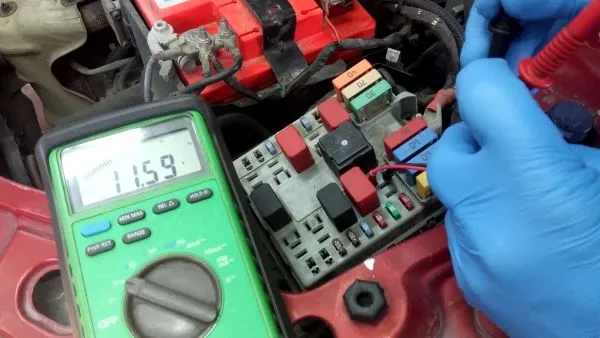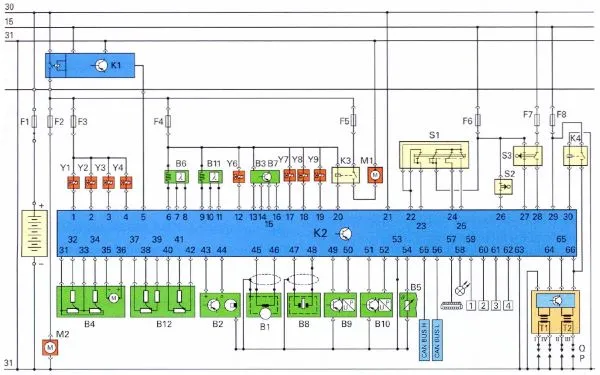Auto Electrical – Testing and Repair
In the chapter Auto Electrical – Testing and Repair, you will learn how to test and repair electrical systems and devices. Automotive electrics includes electrical systems, devices, and components on vehicles. They start the engine, power supply, and electric start of specific devices that ensure the safety, protection, and car comfort.
A proper approach during maintenance, testing, and repair of electrical system elements will contribute to more efficient and faster car servicing. Before the repair, the service technician should learn about the electrical system, the position of the elements on the car, the electrical diagram, and the test and repair procedure. Using the right tools and equipment, the service technician can easily find the cause of the problem and eliminate the fault in the car’s electrical system.[1]
Automotive Electrics
The first cars had purely mechanical systems. Only the ignition system that produced a spark at the spark plug electrodes to ignite the mixture in the engine cylinder was electric. The ignition system had a battery as a DC voltage source and a pair of electrical components: a coil, an ignition switch, an ignition capacitor, and a spark plug. Over time, new electrical devices appeared that made it easier for the driver to ensure safety during driving. Thus, new electrical devices began to be implemented as a mandatory part of the equipment of every car.
The lighting in front of the vehicle, windshield wipers, brake lights, marker lights, turn signals, horn, and lighting inside require maintenance, testing, and repair. Due to the specificity of servicing electrical devices on cars, a new group of service technicians, Auto electricians, appeared. Working on electrical systems requires specific skills, which are different from working on mechanical systems. That’s why service technicians, auto mechanics, and auto electricians were trained separately.
With the development of electrical devices, customer demands and manufacturers’ competition, many new electrical systems have appeared. Today, every car has a radiator fan, an electric fuel pump, a cabin cooling system, power windows, mirrors, seats, a sunroof, ignition, radio, audio system, and many other electrical devices. Each electrical system has prescribed test and repair procedures described in the AutoEdu e-Book chapters.[2]
Auto Electrics – Topic Overview
Auto Electrics – Testing and Repair is part of the AutoEdu e-Book. He is engaged in testing and repairing car electronics. It consists of eight chapters: Electrical Installations, Electrical Components, Accumulators, Lighting, Electrical Devices, Starter, Alternator, and Electric Motors.[3] In each chapter, there are descriptions of the procedure for testing, repairing, and replacing electrical components.
This chapter describes the measurement of fundamental electrical quantities: voltage, current, and resistance. It also provides instructions for using various measuring devices. How can we determine whether there is a short circuit or a break in the installation during the measurement? You can learn how to read an electrical diagram, find the location of electrical components, and the pin layout of component connections. Procedures for checking and replacing fuse installations are presented.[4]
Car Electrical Components
Procedures for testing and repairing fuses, switches, relays, and most basic electrical components on a car are presented.
In this section, you can find out how to choose a suitable battery. See the procedure for battery replacement, charging, testing, and maintenance. Detailed procedures for checking the correctness, maintenance, and replacement of batteries are given. See how the battery is rewired when it is discharged, and the car engine cannot be started. See how to find hidden consumers draining a vehicle is at rest.
Car Lighting
All about choosing and replacing bulbs for exterior and interior car lighting: find out how to adjust the headlight beam. Procedures for checking the lighting supply and checking for correctness are given. How to determine the path of the lighting supply by reading wiring diagrams. You can see how a classic, halogen, xenon, and LED bulb is tested.
Car Electrical Devices
Maintaining electrical devices requires knowledge of their function, operating principles, and servicing procedures. By using the wiring diagram, test and repair procedure, the service technician can quickly and efficiently repair electrical devices in the car.
Engine Starter
This part of the e-book provides procedures for testing and repairing engine starters. Troubleshooting and repair methods for different types of starters are described. Procedures for testing, repairing, and replacing the starter are according to recognized standards and recommendations of vehicle and equipment manufacturers.
An alternator is an indispensable part of every car. A faulty alternator affects the condition of the battery and the operation of electrical and electronic devices on the car. This chapter describes the procedures for testing, determining the cause of failure, repairing, assembling, disassembly, and replacing alternator parts and peripheral components. All procedures are according to the manufacturer’s standardized procedures and recommendations.
Electric Motors on a Car
Many devices in the car are powered by electric motors that convert electrical energy into rotation. Their work is used to start and move many systems such as fans, windshield wipers, window lifters, mirror adjustment, seats, panoramic roof, and other devices on the car. With the successful testing and repair of electric motors, one should know the procedures of measurement and determination of the cause of failure, with prescribed repair and replacement.
Online Auto Electrical Course
Through detailed descriptions of car electrical repair procedures, you can improve your knowledge and expand the skills of an auto electrician.
The key to any successful tip is clarity of description. We tried to make the given instructions simple, readable, and accurate. We hope that the given descriptions of car electrical repair are useful and that, based on this, the reader can more easily understand the procedure and apply the knowledge to car electrical repair.
AutoEdu, as an eBook and an online autoelectrical course, is constantly updated with new topics and repair procedures. Our goal is to provide the information needed to maintain and service automotive electrical systems.












